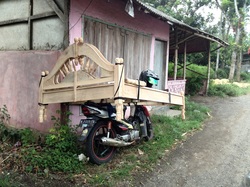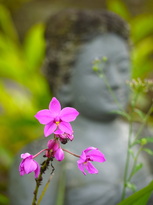
After a pretty lazy day by the pool yesterday, we decided to strike out and discover Bali. Having not seen barely a Western face in Java, it’s immediately obvious that travellers flock here, but what is the magical hold?
Well, for a start, the architecture here is stunning, and it lends a mystical vibe to the island. But it’s not all authentic. For example a third of Tanah Lot, one of Bali’s most famous temples, is artfully constructed artificial rock to conserve the structure from continuous crumbling. There are obviously several opposing views to this: should buildings of historical interest be preserved to a point that there is no history left? Isn’t architectural preservation just as important? At what point do you start reconstruction? Should surrounding structures be built in the same designs? History is a matter of evolution and over time things change. The issue is really about tipping point, but where that point is, is anyone’s guess.
Our first stop today was Batuan village temple. It is a stunning structure, and even if there has been some reconstruction, it has been done sensitively. The designs and thought behind the creation are still intact and visitors can get a glimpse into the past through the stone carvings, which tell a story.
Ubud draws visitors like bees to honey. A mix of rich culture, interesting crafts, cafes and shopping makes it a major pull and travellers often find themselves staying longer than they planned.
Our main focus for the day was the Sacred Monkey Forest Sanctuary, or Mandala Wisata Wanara Wana, home to more than 600 Balinese macaques. The jungle surrounds several 14th century temples, and in the humid conditions the green moss clings to stone. Cheeky monkeys own this place, and visitors are not allowed to forget. Leave your glasses on your head, or a guidebook in your hand, at your peril. As if to demonstrate that they were in charge, they surrounded our three year-old and took the water bottle from out of her hands, untwisted the lid, and drank greedily. They may be used to people, but they are not pets, and a visitor hoping to make a new hairy friend will be disappointed to realise that wild animals are exactly that.
It is, though, a great way to get up close to these creatures, watch them playing and nurturing their young. And it seems that they do have a caring nature. We saw one mother carrying a tiny kitten in her mouth and feeding it. One of the first things a baby monkey learns to do is grab on to its mother for a lift. A kitten is unable to do this, so the adult monkey had adapted and carried the kitten like a mother cat.
Take time to visit the silver and carving workshops too. The artisans’ skills are still very much alive and it makes shopping a more enriching experience when you understand how a product is made, and how the community is supported by its creation.
For an outline itinerary for this two-week trip, please click here. It involves a lot of travel, but the sights are spectacular. It is possible to hire a car and drive though Java yourself but we strongly advise you to hire a local driver. Not only does this make the trip more relaxing, but drivers make excellent tour guides as well. It also gives you the option to take a train for part of the journey to view life through a different window.
For more photographs, please click here.


















 RSS Feed
RSS Feed
